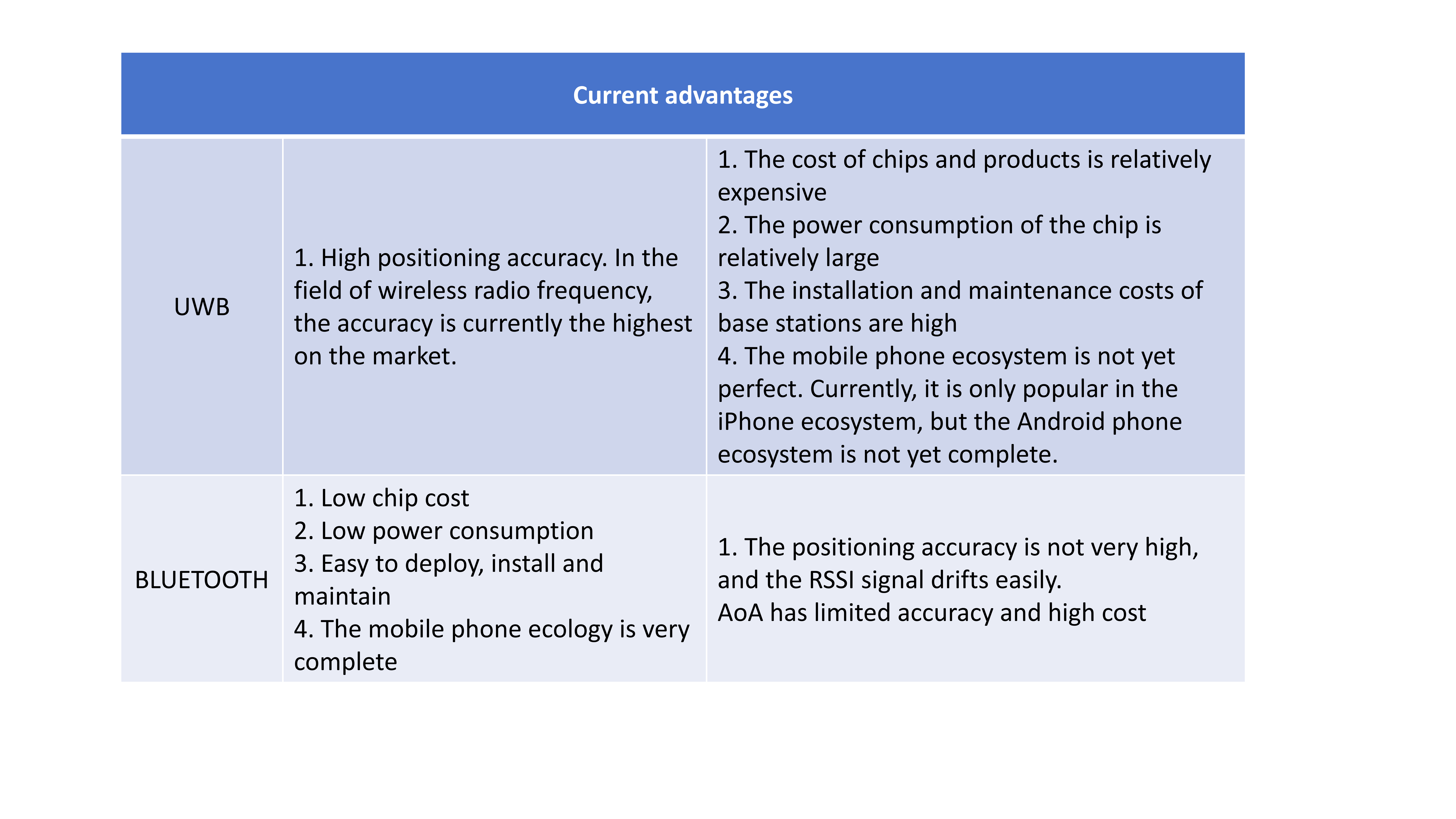 2024.01.10
2024.01.10Integrated positioning solutions are an obvious trend in the industry. Why should integrated positioning be used? Because a single technology cannot meet the demand, or the cost of using a single technology is too high.
But is there a better solution than the convergence of multiple technologies? The answer is that a single technology integrates more capabilities.
To summarize the characteristics of various positioning technologies, the core indicators are as follows:
•High positioning accuracy
•low cost
•Low power consumption
•Easy to deploy, install and maintain
•Whether it is compatible with mobile phones
There is currently no one on the market that can meet all the above requirements, but technology is always evolving and developing. If it is not available now, it does not mean it will not be available in the future.
UWB and Bluetooth are the two most mainstream high-precision positioning technologies on the market and are direct competitors. According to the information we have researched, these two technologies are working hard to be compatible with the characteristics of the other technology.
Advantages and disadvantages of UWB and Bluetooth positioning technology:
 |
Source: AIOT Research Institute
Who has a better chance of winning?
Although the current advantages and disadvantages of UWB are relatively obvious, we found a very interesting phenomenon, that is, UWB is working hard to integrate the advantages of BLE, and BLE is also working hard to make up for the shortcomings of poor positioning accuracy.
The two are stealing from each other, so what are their chances of winning? Let’s briefly analyze it.
Bluetooth's odds
From the above table, we can also intuitively see that Bluetooth technology is indeed excellent. Except for its positioning accuracy, it is perfect in other aspects. This is why many companies in the market still insist on using Bluetooth. The reason for the positioning scheme.
You can take a look at the evolution path of Bluetooth’s positioning capabilities:
The first stage: Based on RSSI (signal strength) positioning, the accuracy error is several meters, and the signal is drifting and unstable. However, this solution retains all other advantages of BLE.
The second stage: AoA positioning. Although the positioning accuracy has been improved to the sub-meter level, the cost of network deployment has greatly increased. If AoD is used, the tag needs to have an array antenna, which is a greater sacrifice for the product.
The third stage: CS channel detection, which improves the positioning accuracy of Bluetooth to about 1m. Because it is based on time-of-flight ranging, the stability of positioning is greatly increased. However, this positioning method requires the Bluetooth chip to continuously send and receive signals, which makes the function Consumption doubled.
In summary, although Bluetooth has been working hard to improve positioning accuracy, the improvement is limited, and some of its other advantages will be sacrificed.
UWB's odd
The biggest advantage of UWB is its high positioning accuracy. As a positioning technology that uses radio frequency technology as the signal source, UWB has the highest positioning accuracy at present.
Although it has many shortcomings in other core indicators besides high positioning accuracy, according to the information we have researched, in the next few years, in addition to the power consumption indicator, UWB technology will have great improvements in several other indicators. Big optimization.
In terms of cost: The wafer cost of UWB chips is similar to that of Bluetooth. Currently, domestic UWB chips have begun mass production. If the market has sufficient volume, the price of UWB chips will drop quickly.
Easy installation and maintenance: UWB-Beacon products currently on the market are beginning to mature, and this product has the same easy installation and maintenance features as Bluetooth Beacon.
In terms of mobile phone ecology: Qualcomm’s UWB kit is expected to be launched in 2024, and UWB will gradually become popular in the Android mobile phone ecosystem.
In terms of power consumption: The power consumption of the chip is currently being gradually optimized, but due to the technical characteristics of UWB, its power consumption is difficult to reach the level of Bluetooth.
In summary, except for the fact that UWB cannot reach the level of BLE in terms of power consumption due to technical characteristics, it can gradually reach the level of BLE in other aspects.
In the end, there is a high probability that a combo ecosystem will be formed.
Reasons for offering to customers as a “combo” product:
Firstly, neither technology will be perfect. Although they are constantly being improved, UWB cannot achieve the low power consumption of BLE, and BLE cannot achieve the high accuracy of UWB. Therefore, the technical complementarity between the two is still very high. obvious.
Secondly, due to the diverse needs of IoT products, many positioning products will add a variety of positioning signal sources to ensure normal use in order to maintain performance stability or to consider whether the users’ mobile phones have UWB or BLE. .
Thirdly, after the cost drops, the cost of adding more functions is not big. The price of BLE chip is already less than 1 yuan. In theory, the price of UWB chip can be similar to that of BLE, even if there are both BLE+UWB. The cost of a chip is only one or two yuan. For many IoT products, this price is lower than the battery cost, labor cost, and even the shell cost.